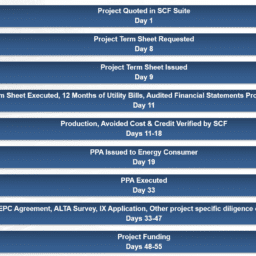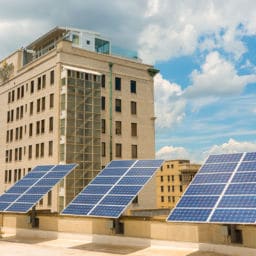 With electricity costs continuing to rise across the US, nonprofit organizations such as schools and universities are looking for new ways to lower their power bills. A solar power purchase agreement, or solar PPA, can be the perfect solution to allow nonprofit organizations such as schools, to enjoy the same tax benefits afforded to homeowners and businesses.
With electricity costs continuing to rise across the US, nonprofit organizations such as schools and universities are looking for new ways to lower their power bills. A solar power purchase agreement, or solar PPA, can be the perfect solution to allow nonprofit organizations such as schools, to enjoy the same tax benefits afforded to homeowners and businesses.
If you are a solar developer that is looking to work with a school/district for the first time, or if your institution is trying to find the right developer, the process may seem daunting. This article will outline the steps involved, illustrate a few challenges and highlight the considerable benefits upon completion.
How does the solar PPA process work for schools and universities?
The process of financing and installing a solar array can be complicated, due to the many parties involved. A solar PPA, however, is the ideal financial structure to eliminate the primary challenge of going solar: funding the upfront cost.
With a PPA, a nonprofit will not be required to provide any upfront capital. Instead, the nonprofit in question will partner with a private solar investment company (such as SCF), who can monetize the federal tax programs that are unavailable to a nonprofit organization. The investment company will then purchase/develop and manage the construction of the solar array on the school’s property. Once completed, the school will be able to buy the generated power at a fixed rate over the set term (typically 20 years).
The market in question will determine the PPA pricing, along with local incentives, rebates and more; this is where Sustainable Capital Finance shines.
SCF has developed a proprietary software solution, the SCF Suite℠, that makes PPA rate or build cost calculation a quick and easy task.
Uncertainty about the end PPA rate is often a barrier for school boards when deciding on a solar installation and it can be hard for a developer or EPC to sell a project when they can’t accurately quote a price or quickly change that quote when needed. The SCF Suite℠ eliminates those concerns, giving developers a portal to promptly update pricing on the fly.
Project case study: SUSD
 To demonstrate the steps involved in a nonprofit PPA project, we’ll be highlighting the Sunnyside School District of Tucson (SUSD). SUSD decided to install solar arrays in 24
To demonstrate the steps involved in a nonprofit PPA project, we’ll be highlighting the Sunnyside School District of Tucson (SUSD). SUSD decided to install solar arrays in 24
locations across the district, a massive undertaking that required securing an experienced developer and finance partner.
1. SUSD created an RFP(Request For Proposal) and released to the public
2. SunRenu, a solar developer in Phoenix, won the proposal
3. SunRenu approached SCF to join as a finance partner
4. Contracts were drafted; in this case, the state of Arizona did not allow PPAs, so a similar agreement called a Solar Service Agreement (SSA) was established
5. Ownerships of the projects were transferred to SCF
6. Wilson Electric was contracted as a general contractor for all 24 locations
7. Wilson worked together with SunRenu to provide design, engineering, permitting and development of the project
SCF performed all site diligence, securing unencumbered access to all of the future solar array sites. Due to SCF’s experience working with both developers, EPCs and Utilities, the process went smoothly, and agreements were put in place with all parties, including both the county and City of Tucson- as well as Tucson Electric Power.
After receiving permits and approval from the Utility (TEP), construction commenced, taking approximately 3-4 months to complete each project from mobilization to commercial operation.
As outlined above, with so many parties involved, it is essential for developers to partner with an experienced and flexible finance partner such as SCF to ensure the project goes smoothly through the entire process.
What are the benefits of a solar PPA for educational institutions?
 For administrators still unsure if switching to solar is the right call, or for developers educating local nonprofits on the benefits, here is a quick breakdown of the main reasons why a school or university should consider a solar PPA:
For administrators still unsure if switching to solar is the right call, or for developers educating local nonprofits on the benefits, here is a quick breakdown of the main reasons why a school or university should consider a solar PPA:
1. A solar array could save hundreds of thousands, if not millions, for the district over the course of the PPA term. With a solar PPA, an educational institution gets the majority of savings from a solar installation without any of the upfront costs. These savings kick in from day one, and will only increase as energy prices climb. Savings from tax benefits are also passed on to the school or university through lower rates, which are not accessible if the system is purchased outright.
2. Schools and Universities often possess ideal rooftop or parking areas for solar arrays. Tilt angles, roofing materials, and the construction type of each roof often affect efficiency as well, making many colleges and K-12s an ideal candidate for solar due to their layout and construction.
3. Solar helps maintain a green image, improves branding and may increase enrollment. Many parents care deeply about environmentally friendly policy, and the ability to advertise a solar project can significantly help to broadcast an environmentally friendly image.
Sustainable Capital Finance is actively acquiring solar projects from developers, at various stages of development. SCF provides invaluable expertise in navigating all aspects of the process, due to our extensive portfolio of successful school and university projects.
Contact SCF today to discuss potential terms for your school or nonprofit solar project.







